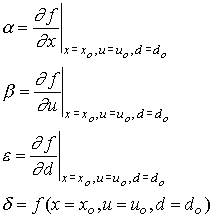
1. Some special parametric forms of second order systems:
Second order systems: tn2 d2x/dt2 + 2 z tn dx/dt + x = f(t)where 1/tn = natural frequencyEigenvalues:
z = damping coefficient

2. Linearization:Case 1: z 1 (overdamped) then s1 and s2 are both real and negative.
Case 2: z=1 (critical damping) then s1 and s2 are equal.
Case 3: 0<z<1 (underdamped) then s1 and s2 are conjugate pair of complex roots,Case 4: z=0 (undamped) then s1 and s2 are both pure imaginary roots.
Case 5: z<0 (unstable) then s1 and s2 are complex pair with positive real parts.
Solution to underdamped with f(t)=Kp, x(0)=xo and dx/dt(0) = 0.with the following additional characteristics: where x1* is the value of the first peak and x2* is the value of the second peak overshooting beyond Kp.
Objective:
To provide a linear approximation of a process model that could predict local behavior around a chosen operating condition.
Procedure:Given:(1)
To obtain a linearized model of equation (1) with respect to the point: xo, uo and do, first obtain the following constants:

then the linearized model is given by
4. General elements of Feedback Control

5. Introduction to PID Control
|
|
|
|
|
|
|
|
|
|
|
|
u = ubias +kc [e + (1/tI) ò e dt ] |
|
|
|
|
|
|
|
Where e = error = xset - x , kc = controller gain , tI = integral time , tD = derivative time